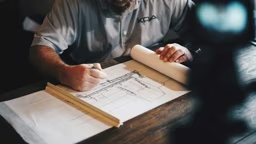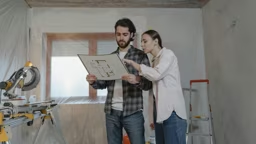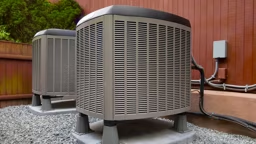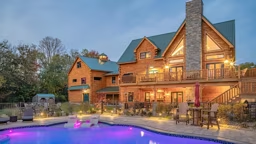 Not every log home has to be dressed to the nines in rustic allure. Some can be downright simple. If you are looking to build an old-school log cabin, here’s how make yours just about perfect.
Not every log home has to be dressed to the nines in rustic allure. Some can be downright simple. If you are looking to build an old-school log cabin, here’s how make yours just about perfect.
1. I want to build a small and simple fishing cabin a couple hours from my house. What do you recommend as far as design?
Small cabins capture the real romance of living among the logs. Start with the same notions that guided our ancestors — small, simple and secure. A traditional rectangle is less expensive to build than a more elaborate shape. It also captures the most usable space when you’re trying to do more with less. Finally, materials and labor costs will be far less if you keep things straightforward. As you
plan your cabin, think about how you’ll use it. Will it be mostly a get-away for you and immediate family members? Or will your cabin serve as a bunkhouse for gatherings of hunting and fishing buddies? Will you use your cabin only seasonally or year around? Think about the cabin experiences you had growing up, perhaps a summer camp or weekend retreats at a friend or relative’s hideaway. What was it about those experiences that tug at your memory, and did they have anything to do with the cabin’s location or design? To
make the most of space, keep interior partitions to a minimum. A simple great room with a corner designated as a kitchen area and a small bathroom can provide a great getaway place for two or three people in only a few hundred square feet. If you need a little more privacy, small bedrooms require less than 100 square feet. I remember a favorite hunting cabin that used a closet and bathroom to separate a sleeping area (complete with bunk beds) from the great room. In hunting season, with a pullout sofa and great-room floor strewn with sleeping bags, it became home to a half-dozen buddies who don’t care much about aesthetics. If you need additional bunk space, a small loft accessed by a ladder can double your available sleeping space. In good weather, decks and porches can further expand your living space. I also wouldn’t overlook storage demands. While it’s not a good idea to leave valuables in a frequently unoccupied cabin, you’ll want to be able to store some recreational equipment and basic cooking and cleaning supplies. A small, well-secured pantry can protect groceries. Before finalizing your design, be sure to check with local building-code authorities to make sure your cabin will meet requirements. Cabins are usually held to slightly different standards than primary residence but still require building permits. Septic systems and wells generally require permits and licensed installers.
See also The Florida Log Home That Withstood Hurricane Irma
2. What should I discuss with my builder before he gets started?
Stress to your builder that you want to build an old-school log cabin, not a showcase home. This shouldn’t be an excuse for shoddy workmanship, but instead, an indication that you’ll be satisfied with simpler construction and more basic materials. If you want to provide some of the materials, spell this out to your builder. You can find bargains on items such as cabinets, appliances, flooring and lumber by watching classified ads in your local newspaper or by visiting scores of bargain-hunter sites online. In many areas, Habitat For Humanity operates stores filled with all manner of used building materials at reasonable prices.
3. I have some modest carpentry skills and lots of buddies who could help me build a cabin on weekends. Give it to me straight: Should I really embark on such a project?
Go for it! Over the years I’ve worked with people who have tackled all aspects of construction with little or no experience. Most of them thoroughly enjoyed the experience and did respectable work. Cabins are great places to test your skills or develop new ones. With a little research and some basic tools, most of the tasks in cabin building are within reach of almost everyone. Still, you’ll need the help of pros in several areas, including the foundation, rough-in plumbing, electrical and HVAC. You also may want to contract with a pro for rough carpentry. Even if you have the skills, a professional may be able to get your cabin shell enclosed and out of lousy weather a lot faster, which will allow you to finish your cabin’s interior at your own pace.
4. What type of heating and cooling options are best with a small camp/cabin? I’m on a budget and want to use the place for fishing and hunting.
In a tiny cabin, a simple fireplace may be all you need. Remember, however, that fireplaces are notoriously inefficient. You’ll go through a lot of wood keeping even a small place warm for extended periods. If you need more heating capacity, consider a wood or pellet stove. These are inexpensive to install and operate, and they’ll heat most small or medium-size cabins easily. Some people heat small cabins with wall-mounted propane heaters. Be careful of this option. Make sure that you vent these heaters according to the manufacturer’s instructions and install carbon monoxide detectors. I’d also avoid the ventless heaters that are often advertised at bargain prices. There are many more heating options as you move up the price scale. You’ll need to weigh their cost against your cabin’s anticipated use. For example, a concrete slab floor with radiant heat—served from a tankless hot-water heater or rooftop solar collector—is an efficient heating option. But the upfront cost will be more than even a top-of-the-line stove. However, if you plan on using your cabin for extended periods in cold weather, the lower operating cost may tip the balance. But if you’ll only be around the cabin on limited weekends, the time lag required to heat a radiant slab will mean that you won’t start feeling much benefit until it’s almost time to leave on Sunday evenings. Unless your cabin is in the desert, your best cooling options are open windows and a nice cross breeze. Make sure your cabin site will be protected from weather and shaded from the summer sun. Of course, small window or ceiling fans can help when breezes fail to cool you off on steamy August nights.
5. What are some design tricks I can employ to keep maintenance to a minimum?
No matter what the size of your log home, the same rules apply—although there are a couple twists with cabins. Make sure your cabin is well above ground level and has roof overhangs that are at least 2 feet. Most building codes call for at least 8 inches clearance between the ground and top of the foundation wall. Try to set your cabin at 16 inches. This will ensure that ground moisture, snow drifts and splashing rain water won’t invade your lower logs. Imagine your cabin as being just dropped into its setting. Remove only those trees necessary for construction and those that might threaten the roof. I’d also keep landscaped areas to a minimum. Trees within 10 to 20 feet of the cabin will require special attention to survive.
6. How do I keep critters from making my cabin their home?
Most cabin memories include tales of the skunk that moved into the crawlspace or the raccoon that climbed down the chimney and dismantled the pantry. Such stories are part of cabin life and live on through generations of family lore. Still, most people would prefer to keep nature at bay. The key to
keeping animals out lies mostly in not giving them reasons to come in. Place your cabin on a completely enclosed crawlspace rather than leaving the foundation open. Don’t stack rocks, debris or firewood too close to your house, and make sure your chimney has a cap and bird screen. Also, be sure windows and doors are sealed tightly. If you live in bear country, avoid storing food in your cabin. Instead, build an elevated storage shed away from the house. When planning to build an old-school log cabin of your own, never lose sight of its intended purpose. For most of us, this means a safe place to sleep, a pleasant place to relax and a shelter from foul weather that still allows us to feel the storm. Remember, a cabin is a means to an end: Planning and building should be fun, and the costs should be minimal. And the memories? Priceless.
SaveSave












